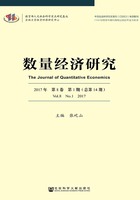
参考文献
陈利平.2007.通货膨胀目标制并不能解决我国货币政策低效率问题——一个基于政策时滞和扰动冲击的研究 [J].经济学(季刊),(4): 1115-1126.
何启志,范从来.2011.中国通货膨胀的动态特征研究 [J].经济研究,(7): 91-101.
孔丹凤,杨少娜.2015.通货膨胀持续性、最优货币政策与通货膨胀目标制 [J].山东大学学报(哲学社会科学版),(1): 35-44.
李永宁,裴广一.2014.年度通货膨胀目标制:国际观照与启示 [J].改革,(8): 44-55.
刘东华.2011.通货膨胀目标制宏观经济效应制“非对称性”的验证 [J].金融研究,(1): 52-63.
刘东华.2009.通货膨胀目标制“锚住”通胀预期的实证检验及其对我国的政策启示 [J].经济科学,(5): 19-32.
卢宝梅.2008.通货膨胀目标制、资产价格膨胀和货币政策反应 [J].经济学动态,(3): 11-18.
奚君羊,刘卫江.2002.通货膨胀目标制的理论思想—论我国货币政策中介目标的重新界定 [J].财经研究,28(4): 4-9.
夏斌,廖强.2001.货币供应量已不宜作为当前我国货币政策的中介目标 [J].经济研究,(8):33-43.
张成思.2008.中国通胀惯性特征与货币政策启示 [J].经济研究,(2): 33-43.
张小宇,刘金全.2012.规则型货币政策与通货膨胀平稳性的内在关联机制研究 [J].经济与管理研究,(9): 25-32.
张小宇,刘金全.2012.货币政策非对称性与惰性区域的识别和检验 [J].管理科学,25(2):98-104.
张学功,左妍.2015.中国通货膨胀持续性非对称特征研究 [J].中国人口·资源与环境,(S1):315-318.
赵昕东,汤丹.2011.中国核心通货膨胀的估计——基于贝叶斯Gibbs Sampler状态空间模型 [J].数量经济研究,(1): 26-37.
Agenor, P. R., M. P. Taylor.1992. Testing for Credibility Effects [J]. IMF Economic Review, 39(3):545-571.
Alogoskoufis, G. S., R. Smith.1991. The Phillips Curve, the Persistence of Inflation and the Lucas Critique:Evidence from Exchange Rate Regimes [J]. American Economics Review, 81(5): 1254-1275.
Alogoskoufis, G. S.1992. Monetary Accommodation, Exchange Rate Regimes and Inflation Persistence [J]. Economics Journal, 102(412): 461-480.
Baxa, J., R. Horváth, B. Vašíˇcek.2014. How Does Monetary Policy Change? Evidence on Inflation Targeting Countries [J]. Macroeconomic Dynamics, 18(3): 593-630.
Benati, L.2008. The“Great Moderation”in the United Kingdom [J]. Journal of Money, Credit and Banking, 40(1): 121-147.
Bleaney, M.2000. Exchange Rate Regimes and Inflation Persistence. IMF Economic Review, 47(3):387-402.
Cuestas, J. C., B. Harrison.2011. Inflation Persistence and Nonlinearities in Central and Eastern European Countries [J]. Economics Letters, 106(2): 81-83.
Defina, R. H., H. E. Taylor.1993. Monetary Policy and Oil Price Shocks: Empirical Implications of Alterna tive Responses [J]. Applied Economics, 25(6): 777-785.
Gerlach, S, P. Tillmann.2012. Inflation Targeting and Inflation Persistence in Asia-Pacific [J]. Journal of Asian Economics, 23(4): 360-373.
Levin, A. T., F. M. Natalucci, J. M. Piger.2004. The Macroeconomic Effects of Inflation Targeting [J]. Federal Reserve Bank of St. Louis Review, 86(4): 51-80.
Mendonça, H. F. D.2012. Is Inflation Targeting a Good Remedy to Control Inflation? [J]. Journal of Development Economics, 98(2): 178-191.
Mishkin, F. S.2007. Inflation Dynamics [J]. International Finance,(10): 317-334.
Siklos, P. L.1990. Hyperinflations: Their Origins, Development and Termination [J]. Journal of Economic Surveys, 4(3): 225-248.
Siklos, P. L.1997. Exchange Rate Regimes and Shifts in Inflation Persistence: Does Nothing Else Matter? [J]. Journal of Money, Credit and Banking, 31(2): 235-247.
Siklos, P. L.1999. Inflation-target Design: Changing Inflation Performance and Persistence in Industrial Countries [J]. Ssrn Electronic Journal, 81(Mar): 46-58.
Taylor, S. J., B. G. Kingsman.1979. An Analysis of the Variance and Distribution of Commodity Price Changes [J]. Australian Journal of Management, 4(2): 135-149.
Walsh, C. E.2010. Monetary Theory and Policy [M]. Cambridge, Mass: MIT Press, p.640.